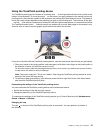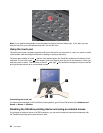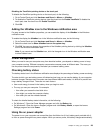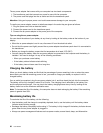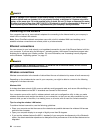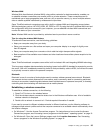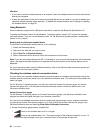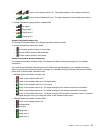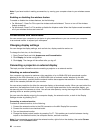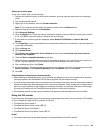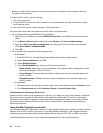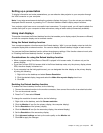
Wireless WAN
Wireless Wide Area Network (wireless WAN), using cellular networks for data transmission, enables you
to establish wireless connections over remote public or private networks. These connections can be
maintained over a large geographical area, such as a city or an entire country, by use of multiple antenna
sites or satellite systems maintained by wireless service providers.
Some ThinkPad notebook computers come with a built-in wireless WAN card integrating some wireless
WAN technologies, such as 1xEV-DO, HSPA, 3G, GPRS or LTE. By using the built-in wireless WAN card and
the conguration utility that comes with your computer, you can establish wireless WAN connections and
monitor the status of your connection.
Note: Wireless WAN service is provided by authorized service providers in some countries.
Tips for using the wireless WAN feature
To achieve the best connection, use the following guidelines:
• Keep your computer away from your body.
• Place your computer on a at surface and open your computer display to an angel of slightly more
than 90 degrees.
• Place your computer away from concrete or brick walls that might dampen cellular signals.
• Best reception will be available near windows and other locations where cellular phone reception is the
strongest.
WiMAX
Some ThinkPad notebook computers come with a built-in wireless LAN card integrating WiMAX technology.
This long-range wireless data transmission technology based on the 802.16 standard is expected to provide
the user a “last mile” broadband connectivity similar to that provided by cable or ADSL, but without the need
to physically connect a cable to the personal computer.
Bluetooth
Bluetooth is one of a number of technologies used to create a wireless personal area network. Bluetooth
can connect devices a short distance from one another, and is commonly used for connecting peripheral
devices to a computer, transferring data between hand-held devices and a personal computer, or remotely
controlling and communicating with devices such as mobile phones.
Establishing a wireless connection
To establish a wireless connection, do the following:
1. Press Fn+F5 to turn on the wireless feature.
2. Click the wireless network connection status icon in the Windows notication area. A list of available
wireless networks is displayed.
3. Double-click a network to connect to it. Provide required information if needed.
If you need to connect to different wireless networks in different locations, use the following software to
manage multiple network proles so that the computer connects to an available network automatically when
the location changes:
• For Windows 7: Use the Access Connections program. For instructions on how to start the Access
Connections program, see “Accessing Lenovo programs on the Windows 7 operating system” on page 15
.
• For Windows 8: Open the Lenovo Settings program and click Location Awareness. See “Accessing
Lenovo programs on the Windows 8 operating system” on page 16
.
Chapter 2. Using your computer 35



